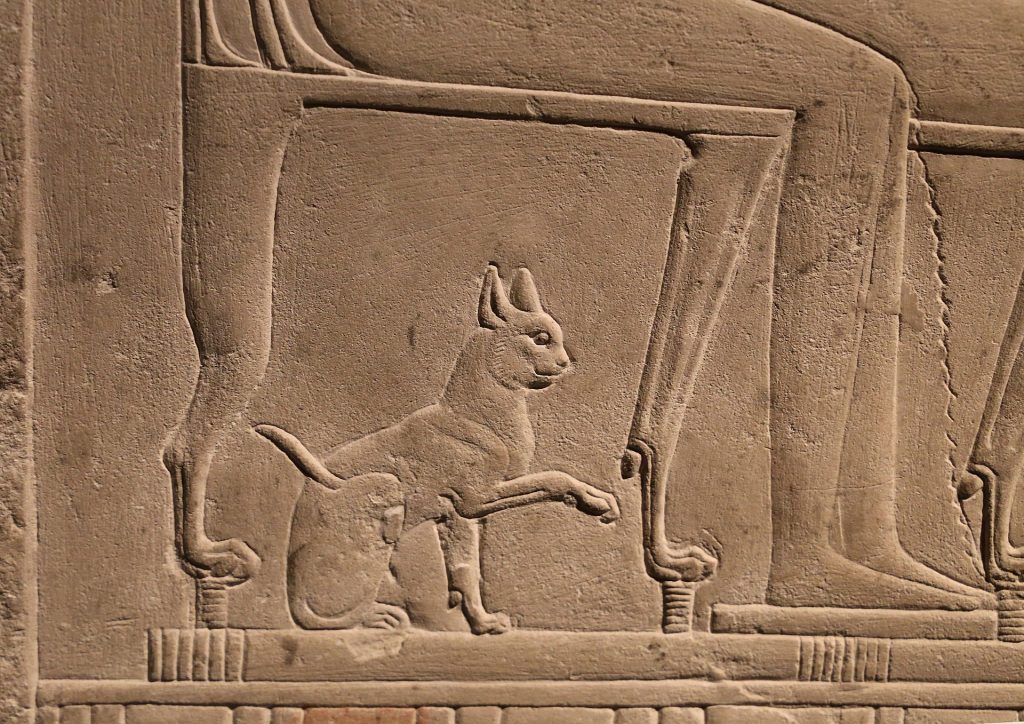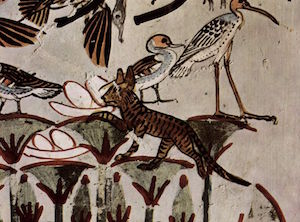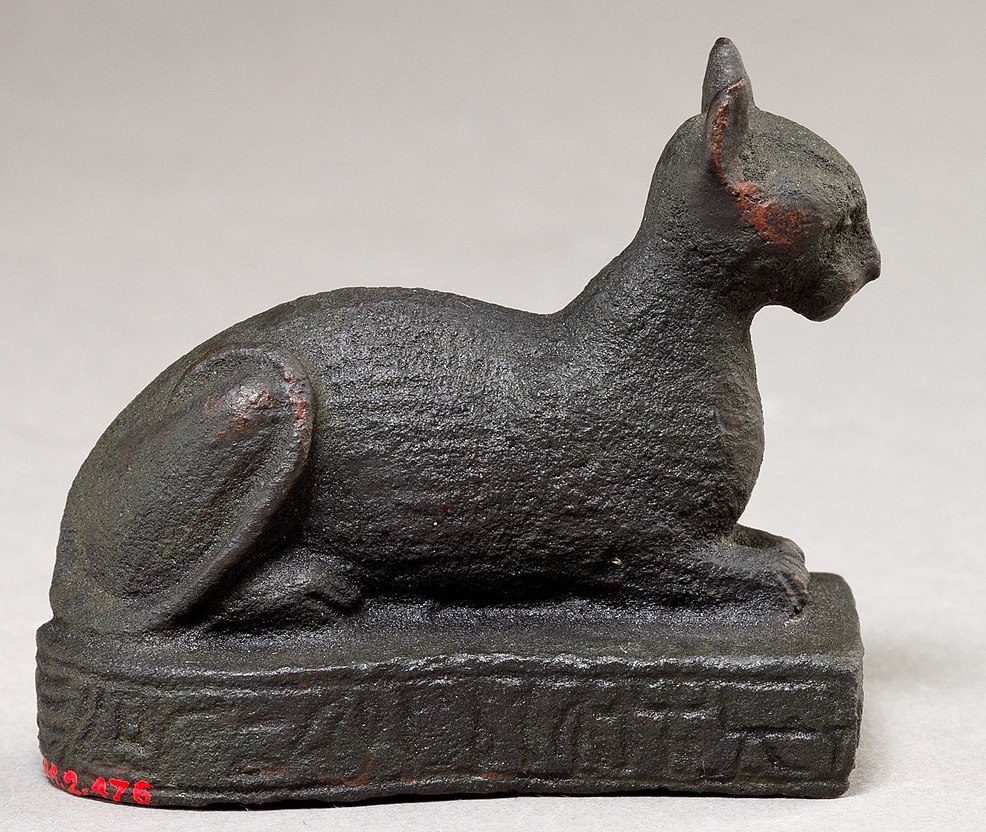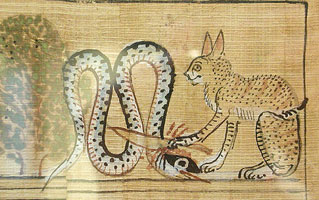
The ancient Egyptians were respectful towards the animals that shared their world and associated many of them with deities or positive human characteristics. However, no animal was held in such esteem as the cat. Cats were closely connected to a number of gods and goddesses, and there is evidence that they were considered to be demi-gods in their own right. As an inscription in the Valley of the Kings states;

“You are the Great Cat, the avenger of the gods, and the judge of words, and the president of the sovereign chiefs and the governor of the holy Circle; you are indeed the Great Cat.”
As a primarily agrarian society, the ancient Egyptians had a distinct problem with mice, rats and snakes all of whom threatened the grain stores. It is thought that the ancient Egyptians learned that wild cats preyed on these scavengers and so began to leave out food (such as fish heads) to tempt the cats to visit them regularly. This suited the cats perfectly as being close to human settlements not only provided them with a ready supply of food (the vermin and the food left by humans) but also helped them to avoid larger predators. As this symbiotic relationship developed cats were welcomed indoors and eventually consented to move in with their human friends and rear their kittens in the safety of the home.
Their diet changed somewhat as they were provided with food by grateful humans, and breeding programs heightened certain characteristics in the formerly wild animals. The ancient Egyptians even hunted with their cats, a seemingly amazing feat of co-operation with an animal renowned for its stubborn individualism. Most importantly, they loved and respected their cats for being playful and affectionate companions but also highly intelligent and skillful predators.


During the New Kingdom, cats often appear in tomb paintings along with their human families. People were often depicted on hunting trips with their cats. These scenes should not necessarily be taken at face value. The family are often wearing their best clothes and expensive jewellery – not the best attire for a hunting trip. Rather, these “fishing and fowling” scenes represent the triumph of order over chaos. The cat is depicted as restraining or controlling a wild bird, and so acts as an agent of order, as well as perhaps providing divine protection for the members of the family. Particularly interesting is the scene in the tomb of Nebamun in which it was discovered that the eye of the cat is decorated with gold inlay – the only part of the tomb decorations to feature this effect. Not only would this make the cat’s eye glimmer in a lifelike manner, it reinforces the solar and divine nature of the cat.


One of the most common (and in my view the sweetest) representations found in tombs depicts the cat sitting under or beside the chair of the mistress of the house (right) offering her protection and friendship, a connection made all the more important because of the association of cats with some of the most powerful goddesses.
The Egyptians did not distinguish between a wild cat and a domesticated cat; all cats were known as “miu” (or “miut”) often translated as “he or she who mews”. The origin of this name is not clear but it seems likely that it is an onomatopoetic reference to the sound a cat makes (mew). However, some commentators have suggested that it also related to the word miw (to see). It seems that it was rare for a cat to be given its own specific name (rather than being called “miu” or “miut”). There are exceptions such as the cat named “Nedjem” (“sweetie”). Little girls were often named “Miut” (literally meaning “female cat”) displaying the Egyptians fondness for both cats and children.
Cats were also important in the interpretation of dreams. Apparently seeing a cat in your dream confirmed that you would have a good harvest.
History
There were two main breeds of cat native to ancient Egypt. The jungle cat (Felis chaus) and the African wildcat (Felis silvestris lybica). The latter had a calmer temperament and so was more commonly domesticated than its wilder relative. The two species eventually merged creating a new breed which was closely related to the modern Egyptian Mau. As the cat was domesticated, further changes in temperament and appearance became apparent. Cats became more colourful (as the need to be almost permanently camouflaged lessened), their bodies became smaller and less muscled (due to changes in diet and activity), their brains became smaller (as a result of the reduction in necessary survival instincts) and they developed an increased tolerance for humans.




It seems that the cat is in fact indigenous to Egypt. There is evidence that the majority of the world’s cats can trace their ancestry to an Egyptian cat. It is sometimes suggested that cats were introduced into Egypt from Persia around 2000 B.C.E or from Nubia during the New Kingdom but this is unlikely due to significant evidence that cats lived in Egypt before these dates. In fact, archaeologists found a man interred with his cat in a burial mound in Mostagedda near Asyut dated to around 6,000 years ago. The cat may not have been domesticated, but was clearly important to the deceased. It is generally suggested that cats were domesticated in Egypt around 2000 B.C.E. Dogs had already been domesticated for over a thousand years by this time.




When the town of Bubastis (Per-Bast) was established as the royal residence by Shoshenq I (Dynasty Twenty-two) the goddess Bast was promoted to a position of great power, as were the cats with whom she was so closely associated. Herodotus visited Bubastis in 450 B.C.E. and noted that although the temple of Bast was “not as large as those of other cities, and probably not as costly, no temple in all of Egypt gave more pleasure to the eye”. He also confirmed that the annual festival of Bast held in the city was the one of the most popular in all of Egypt. Hundreds of thousands of pilgrims came from all over Egypt to celebrate by drinking, dancing and singing, and to pray to the goddess for her favour over the coming months. The festival was so famous that it made it onto a hit list of the prophet Ezekiel (Ezekiel 30:17, sixth century B.C.E.) who warned that “The young men of Aven and of Pibeseth (Bubastis) shall fall by the sword: and these cities shall go into captivity”.
Bubastis was destroyed by the Persians in 350 B.C.E. and the cult of Bast was officially banned by imperial decree in 390 AD and the fortunes of the cat waned with the demise of the goddess. The cat was no longer divine or an incarnation of a god.
Gods associated with Cats
The most famous cat deity was Bast but there are also a number of other ancient Egyptian gods who were associated with cats. Neith occasionally took the form of a cat and the cat was one of Mut’s sacred symbols.


Both the Book of Gates and the Book of Caverns refer to a cat god named Miuty (or Mati or Meeyuty). This god protects the Eleventh Division of the Duat in the Book of Gates (the division just before dawn) and watches over the enemies of Ra in the Book of Caverns. It is also possible that this deity is one and the same as “Mauti” who is depicted in the Tomb of Seti II and may also refer to Mau or Mau-Aa (the great cat) as a form of Ra.
In the Seventeenth Chapter of the Book of the Dead, Ra takes on the form of a cat named simply “Mau” (cat) in order to kill the serpent Apep. The text reads;
“I am the cat (Mau), who fought hard by the Persea tree in Annu on the night when the foes of Neb-er-tcher (a form of Osiris) were destroyed”, The male cat is Ra himself and he is called “Mau” because of the words of the god Sa, who said about him, “who is like (mau) unto him?” and thus his name became “Mau” (cat). “
Cats were also associated with the “Eye of Ra” and linked to the goddess Isis because they were perceived to be great mothers.
Status of Cats
Many animals were seen as the representatives of gods (for example, crocodiles, hawks and cows) but the animals themselves were not considered to be divine. However, there is some evidence that every cat was considered to be a demi-god (although some Egyptologists do not agree). According to one theory, the cat as a semi-divine being could not be owned by a mere human. Only the pharaoh had a high enough status to own a cat. Thus all cats were under the guardianship of the pharaoh and harming a cat was treason.


As a result, there were extremely heavy penalties for harming cats throughout Egyptian history. At the height of Bast’s popularity killing a cat, even accidentally, was punishable by death. Diodorus Siculus wrote “Whoever kills a cat in Egypt is condemned to death, whether he committed this crime deliberately or not. The people gather and kill him. An unfortunate Roman, who accidentally killed a cat, could not be saved, either by King Ptolemy of Egypt or by the fear which Rome inspired.” However, some feline mummies recovered from Bubastis display severe trauma to the head or neck, indicating that they had been intentionally killed. This, of course, contrasts with the law regarding the killing of cats. However, it is thought that this action was considered acceptable in Bubastis to prevent an explosion of the feline population and that all the cats were offered to Bast (and would therefore live eternally in kitty-heaven). Anyone else deliberately harming a cat was in deep trouble.



It was apparently illegal to export cats to neighbouring countries. This led to a thriving trade in smuggled cats! Court records confirm that armies were occasionally dispatched to rescue the kidnapped felines and bring them home to Egypt.
Herodotus claimed that on discovery of a house fire, the men from the house would line up outside the building to protect the cats from danger. He suggested that the cats would “leap into the fire” unless protected by the men, which seems rather unlikely, unless their kittens were still inside the home. This story may well be made up or exaggerated, but again highlights the high status of the cat in Egyptian society.
Herodotus also recorded that the Persians used the Egyptian’s love of cats against them. Apparently, the Persians captured a large number of cats and let them loose on the battlefield outside Pelusium. When the Egyptians saw the terrified cats running around the battlefield, they surrendered rather than risk harm to their beloved friends.
Mummification and Burial


Mummification was not reserved for human burials. Sometimes Egyptians would mummify pet cats. Diodorus recorded that when a cat died, their human family would go into a deep mourning and shave their eyebrows. The cat was wrapped in linen and “treated with cedar oil and such spices as have the quality of imparting a pleasant odour and of preserving the body for a long time.” The cat would then be buried along with provisions such as milk, mice and rats.
Cats were also mummified as a votive offering to the goddess Bast. The mummified cats were most often buried in Bubastis, but tombs have also been discovered in Giza, Abydos, Denderah and Beni Hasan. For example, a tomb in Beni Hassan was discovered in 1888 which contained an estimated 80,000 feline burials. These cats, unlike beloved pets, seem to have been bred for this purpose and intentionally killed (by strangulation or blunt force to the head) which suggests that the Egyptians were not always sentimental about their cats!
Bibliography
- Bard, Kathryn (2008) An introduction to the Archaeology of Ancient Egypt
- Burton, Anne (1973) Diodorus Siculus, Book 1
- Ikram, Salima (2003) Death and Burial in Ancient Egypt
- Grajetzki, W (2003) Burial Customs in Ancient Egypt
- Kemp, Barry J (1991) Ancient Egypt: Anatomy of a Civilisation
- Pinch, Geraldine (2002) Handbook Egyptian Mythology
- Trigger, B.G, Kemp, B.J, O’Connor. D, Lloyd. A.B (1983) Ancient Egypt, A Social History/li>
- Wilkinson, Richard H. (2003) The Complete Gods and Goddesses of Ancient Egypt
- Wilkinson, Richard H. (2000) The Complete Temples of Ancient Egypt
Copyright J Hill 2010